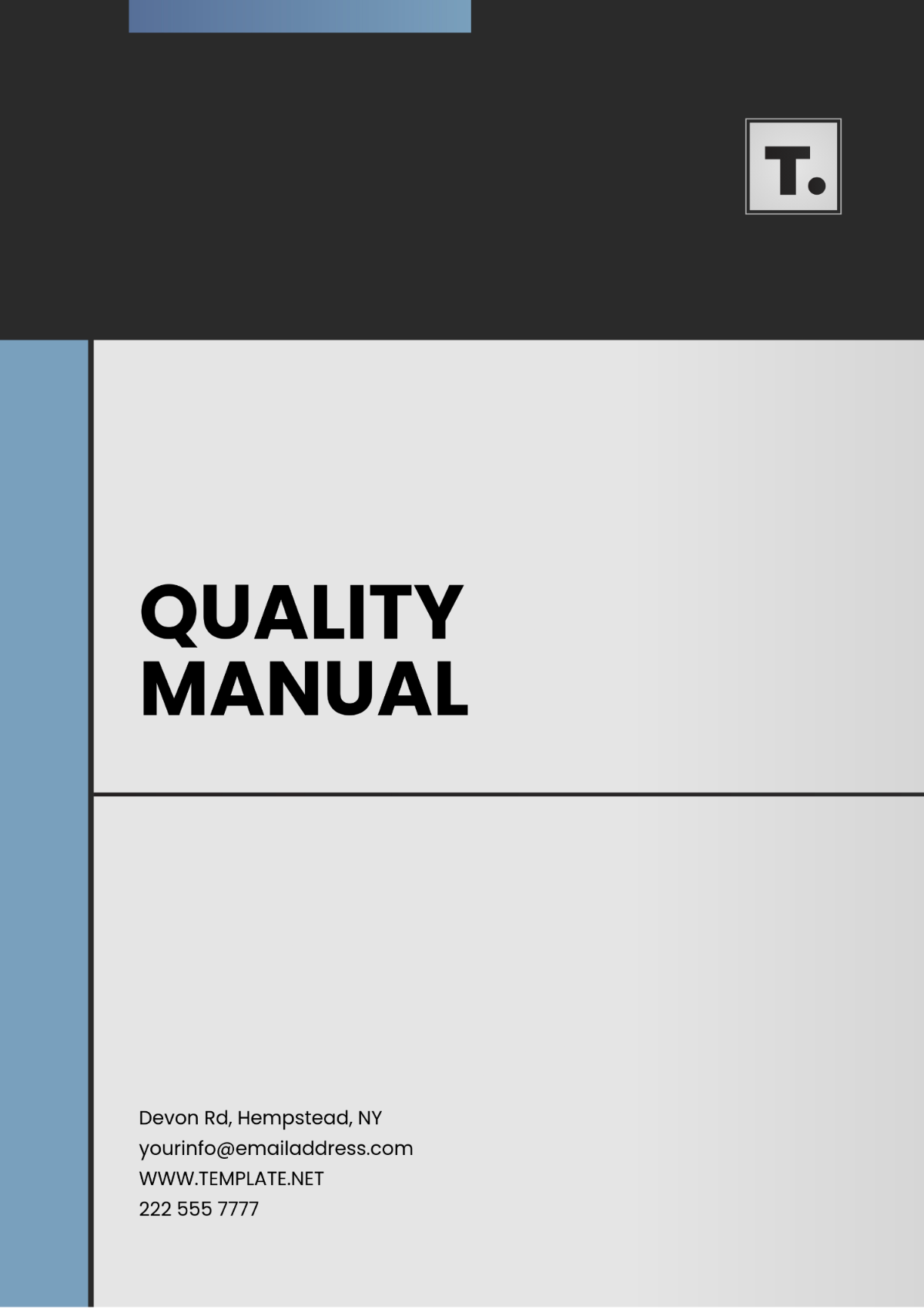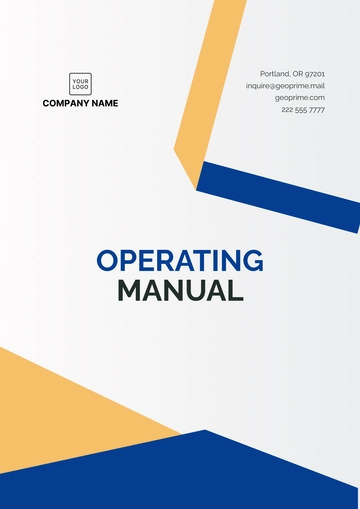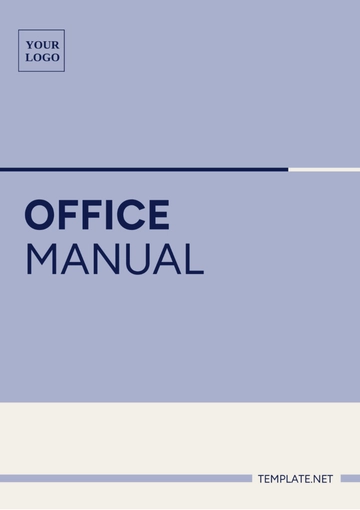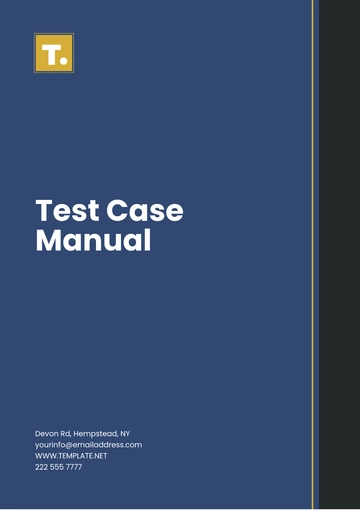Free Quality Manual

NAME: | [YOUR NAME] |
|---|---|
COMPANY: | [YOUR COMPANY NAME] |
DEPARTMENT: | [YOUR DEPARTMENT] |
DATE: | [DATE] |
I. Introduction
Welcome to the Quality Manual for [YOUR COMPANY NAME]. This manual serves as a guide to understanding our organization's quality management system (QMS) and its implementation across all departments and functions. The QMS is designed to ensure that our products/services consistently meet customer requirements and comply with relevant standards and regulations. [YOUR COMPANY NAME] is committed to delivering high-quality products/services and achieving customer satisfaction through continuous improvement and adherence to quality principles.
II. Quality Policy
At [YOUR COMPANY NAME], we are dedicated to maintaining the highest standards of quality in all aspects of our operations. Our quality policy reflects our commitment to excellence and customer satisfaction. The key elements of our quality policy include:
Customer Focus: We prioritize understanding and meeting the needs and expectations of our customers.
Continuous Improvement: We continually strive to improve our processes, products, and services to enhance quality and efficiency.
Compliance: We adhere to all applicable laws, regulations, and standards to ensure legal compliance and ethical business practices.
Employee Involvement: We engage and empower our employees to contribute to quality improvement initiatives and foster a culture of accountability and ownership.
Risk Management: We identify and mitigate risks that may impact the quality of our products/services to prevent quality-related issues.
III. Organizational Structure
[YOUR COMPANY NAME]'s organizational structure plays a crucial role in the effective implementation of our quality management system. Our organizational chart defines roles, responsibilities, and reporting relationships to ensure clear communication and accountability throughout the organization. Key stakeholders involved in quality management include:
Top Management: Responsible for establishing the quality policy, objectives, and strategic direction of the organization.
Quality Management Representative: Serves as the primary point of contact for quality-related matters and ensures compliance with QMS requirements.
Department Heads/Managers: Oversee quality-related activities within their respective departments and support the implementation of quality initiatives.
IV. Quality Management System
The Quality Management System (QMS) at [YOUR COMPANY NAME] encompasses the processes, procedures, and resources needed to achieve quality objectives and ensure consistent product/service quality. Our QMS is based on the principles of ISO 9001 and tailored to meet the specific needs of our organization. Key components of our QMS include:
Quality Policy and Objectives: Our quality policy outlines our commitment to quality excellence, while quality objectives provide measurable targets for continuous improvement.
Documented Procedures: We maintain documented procedures for key quality processes, including product/service realization, internal audits, and corrective/preventive actions.
Risk-Based Approach: We employ a risk-based approach to quality management, identifying and addressing risks that could impact product/service quality and customer satisfaction.
Performance Measurement: We monitor and measure the performance of our QMS through key performance indicators (KPIs) and conduct regular management reviews to assess effectiveness and identify areas for improvement.
V. Quality Processes
[YOUR COMPANY NAME] has established a set of quality processes to ensure the consistent delivery of high-quality products/services. These processes cover various aspects of our operations, including:
Product/Service Design and Development: Our design and development process ensures that customer requirements are translated into well-defined product/service specifications. We utilize advanced design tools and methodologies to create innovative solutions that meet or exceed customer expectations.
Purchasing and Supplier Management: We maintain rigorous criteria for selecting and evaluating suppliers to ensure they meet our quality standards. Our supplier management process includes supplier qualification, performance monitoring, and regular audits to ensure compliance with contractual requirements.
Production/Service Delivery: Our production/service delivery process focuses on maintaining consistency and efficiency while minimizing defects and errors. We adhere to standardized procedures and employ quality control measures at every stage of production/service delivery to ensure compliance with specifications and customer requirements.
Quality Control and Inspection: We conduct thorough quality control inspections throughout the production/service delivery process to identify and address any deviations from quality standards. Our quality control measures include in-process inspections, final product/service inspections, and testing to verify conformity with specifications.
Customer Feedback and Complaint Handling: We actively solicit feedback from customers to assess their satisfaction levels and identify opportunities for improvement. Our complaint-handling process ensures the timely resolution of customer complaints and the implementation of corrective actions to prevent recurrence.
VI. Document Control
Effective document control is essential for maintaining the integrity and traceability of our quality management system. Our document control process includes the following key elements:
Document Identification: All documents within our QMS are uniquely identified and classified according to their type and purpose.
Document Approval and Review: Documents undergo a formal approval process before being issued, and periodic reviews are conducted to ensure they remain relevant and up-to-date.
Document Distribution: Documents are distributed to authorized personnel through a controlled distribution system to prevent unauthorized access or use.
Document Revision Control: Any changes to documents are managed through a documented change control process to maintain document integrity and traceability.
Document Retention and Disposal: Documents are retained for a defined period as specified in our retention policy, after which they are securely disposed of to prevent unauthorized access or use.
VII. Training and Competence
Ensuring that employees are adequately trained and competent to perform their roles is critical to the success of our quality management system. Our training and competence process includes the following key elements:
Training Needs Analysis: We conduct a thorough analysis of training needs to identify gaps in knowledge and skills.
Training Plan Development: Based on the training needs analysis, we develop comprehensive training plans that address the specific needs of individual employees and departments.
Training Delivery: Training is delivered through various methods, including classroom instruction, on-the-job training, e-learning modules, and workshops.
Competence Assessment: We regularly assess the competence of employees through written tests, practical assessments, and performance evaluations.
Training Records Management: Records of training activities, including attendance, completion, and assessment results, are maintained in a centralized database for easy access and reference.
VIII. Monitoring and Measurement
Monitoring and measurement are essential aspects of our quality management system to ensure that processes are performing as intended and that quality objectives are being achieved. Our monitoring and measurement process includes:
Key Performance Indicators (KPIs): We define and monitor KPIs relevant to our quality objectives and operational processes to gauge performance and identify areas for improvement.
Process Monitoring: We regularly monitor critical processes to ensure they are operating within specified parameters and meeting quality requirements.
Product/Service Inspection: We conduct inspections and tests at various stages of production/service delivery to verify conformity with specifications and customer requirements.
Customer Satisfaction Surveys: We periodically survey customers to assess their satisfaction levels and gather feedback on our products/services.
Internal Audits: We conduct regular internal audits of our quality management system to ensure compliance with standards, identify nonconformities, and implement corrective actions.
IX. Nonconformity and Corrective Action
In the event of a nonconformity or deviation from quality standards, our organization has established procedures for identifying, documenting, and addressing nonconformities promptly. Our nonconformity and corrective action process includes:
Nonconformity Identification: Nonconformities are identified through internal audits, customer complaints, quality control inspections, or other monitoring activities.
Nonconformity Investigation: We investigate the root cause of nonconformities to determine the underlying factors contributing to the deviation from quality standards.
Corrective Action: Based on the investigation findings, corrective actions are developed and implemented to address the root cause of nonconformities and prevent recurrence.
Verification of Effectiveness: The effectiveness of corrective actions is verified through follow-up inspections, tests, or audits to ensure that the nonconformity has been adequately addressed.
Documentation and Reporting: All nonconformities and corrective actions are documented, reported, and retained as part of our quality records for future reference and continuous improvement.
X. Conclusion
Congratulations! You have now completed the Quality Manual Template for [YOUR COMPANY NAME]. This manual serves as a comprehensive guide to understanding and implementing our organization's quality management system (QMS). By following the guidance outlined in this manual, we aim to ensure consistent product/service quality, meet customer requirements, and continuously improve our processes and performance.
Remember, quality is not a destination but a journey. Continuous improvement is the cornerstone of our QMS, and we must remain vigilant in identifying opportunities for enhancement and implementing effective solutions. By working together and embracing a culture of quality, we can ensure the long-term success and sustainability of [YOUR COMPANY NAME].
- 100% Customizable, free editor
- Access 1 Million+ Templates, photo’s & graphics
- Download or share as a template
- Click and replace photos, graphics, text, backgrounds
- Resize, crop, AI write & more
- Access advanced editor
Introducing the Quality Manual Template from Template.net: an indispensable resource for businesses seeking excellence. This meticulously crafted document is fully editable and customizable, empowering you to tailor it to your unique needs. With seamless integration into our Ai Editor Tool, streamline your quality management effortlessly.





























